- Matching (Score)
- Our verdict
- Competing TVs
- TV appearance
- Where to buy
- Contrast and black detail
- HDR effect quality
- Factory color reproduction
- Color reproduction after calibration
- Smoothness of tonal transitions
- Image scaling and smoothness of tonal transitions
- Blur and motion smoothness
- Console compatibility and gaming features
- Input lag
- Compatibility with PC
- Viewing angles
- Daytime performance
- TV features
- Apps
- Playing files from USB
- Sound
- Panel details
Panasonic W95B Review
Available screen sizes:

Complete the survey to find out the result
Panel type: LCD VA Refresh rate: 144Hz Brand: PANASONIC Resolution: 3840x2160 System: Amazon FireTV Model year: 2025
The Panasonic W95B is the latest flagship LCD from the Japanese, designed to respond to the ever-stronger competition from OLEDs and Mini-LEDs of other brands. The question remains: will it be able to break the barrier that has weighed down Panasonic televisions for several years? We all remember that the company was known for its natural colours and cinematic image quality, but in recent seasons it has struggled to stand out in a world where not only image quality matters but also smart features and options for gamers. Will the W95B allow this Japanese legend to return to the game and stand out in the crowd of all these televisions? We have prepared a test to answer this question.

PANASONIC W95B - Our verdict
7.5
Overall rating
The Panasonic W95B is one of those televisions that not only impresses with its specifications on paper but also delights in practice. It boasts an excellent Mini LED screen, offering remarkable black levels, very high brightness, and smooth motion, which combined with refined local dimming create an image close to perfection. Most content simply looks stunning on it, and the low-latency gaming mode with support for key technologies makes it a good choice for gaming as well. However, it is important to remember that the W95B is aimed at a rather specific group of consumers – those who can accept weaker usability features in exchange for good image quality. The Fire TV system in this version is not very polished: several apps are missing, some functions operate clumsily, and the built-in file player doesn't even support subtitles. Despite these shortcomings, the Panasonic W95B is a solid, well-crafted visual device that proves Mini LED can be a true alternative for those who, for various reasons, do not want an OLED television. It is one of the few televisions of this type that can be wholeheartedly recommended, provided that the priority is the image, rather than the system and applications.
Advantages
Excellent black levels and contrast thanks to 504 local dimming zones and a VA panel
Very high HDR brightness (up to 1400 nits)
Good motion fluidity. 144 Hz panel – perfect for gaming and dynamic content
Support for Dolby Vision, HDR10+
Many features for gamers including: HGiG, ALLM, FreeSync, and G-Sync
Low input lag
Well-functioning upscaling and subtle digital image processing
High brightness in daylight and effective anti-reflective coating
Pleasant sound with Dolby Atmos support
USB recording capability, Bluetooth, and jack input
Disadvantages
The Fire TV system is poorly developed in Europe – many applications are missing
Clunky interface operation and software bugs, e.g. lack of subtitles when playing films from USB
Local dimming does not work in VRR mode
Narrow viewing angles – typical for VA panels
Only two HDMI 2.1 ports
Movies and series in UHD quality
7.3
Classic TV, YouTube
7.4
Sports broadcasts (TV and apps)
7.2
Gaming on console
8.6
TV as a computer monitor
8.4
Watching in bright light
7.2
Utility functions
6.8
Apps
7.2
Sound quality
7.9
Complete the survey to find out what fits your preferences
PANASONIC W95B - Competing TVs in this price range
PANASONIC W95B - TV appearance
HDMI inputs: 2 x HDMI 2.0, 2 x HDMI 2.1 (48Gbps) Outputs: Toslink (Optical audio), eARC (HDMI), ARC (HDMI), Mini-Jack (Headphones) Network Interfaces: Wi-Fi 2.4GHz, Wi-Fi 5GHz, Ethernet (LAN) 100Mbps
Build quality: BuildQuality-Good
Stand type: Central
Bezel color: Silver

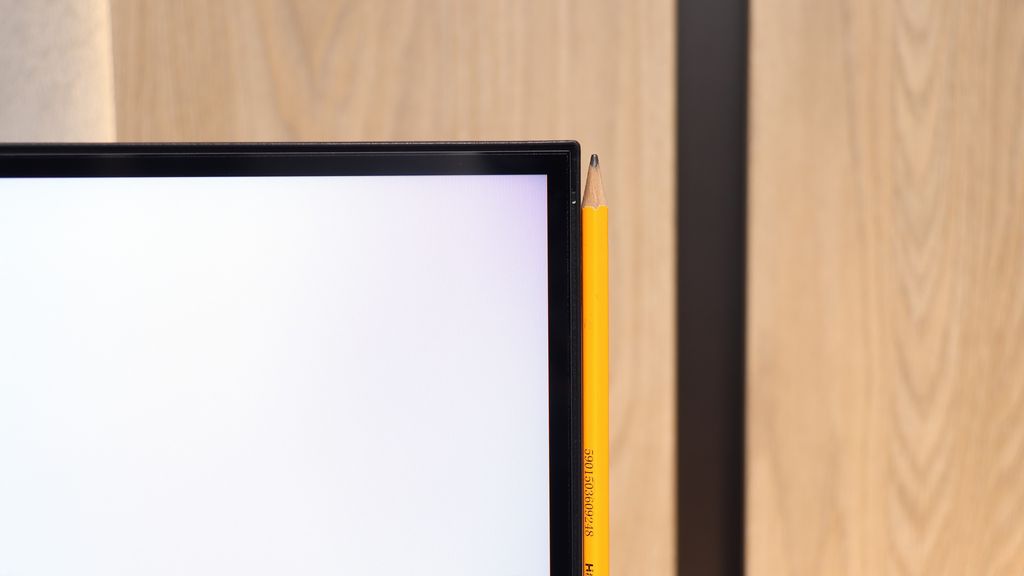
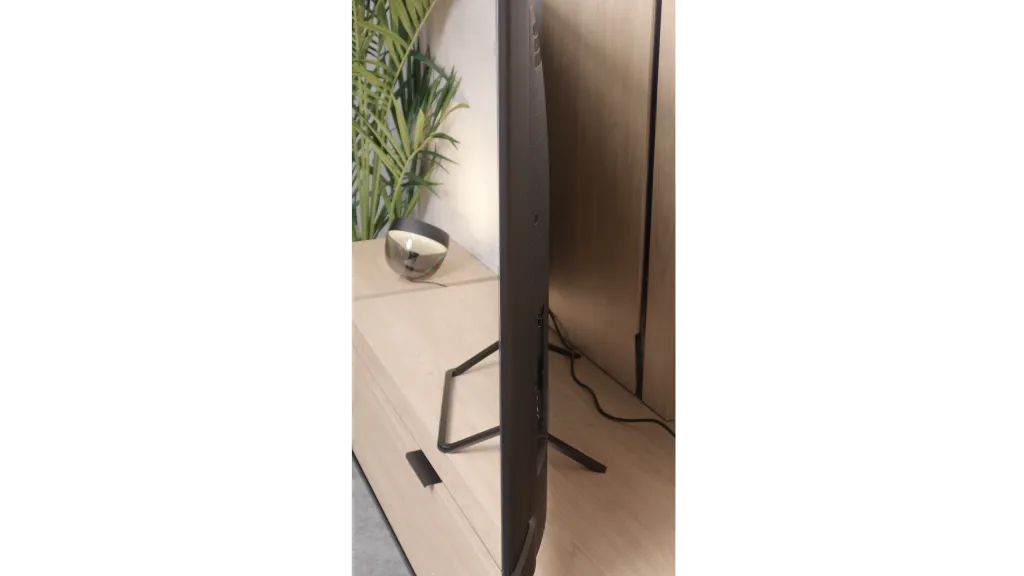
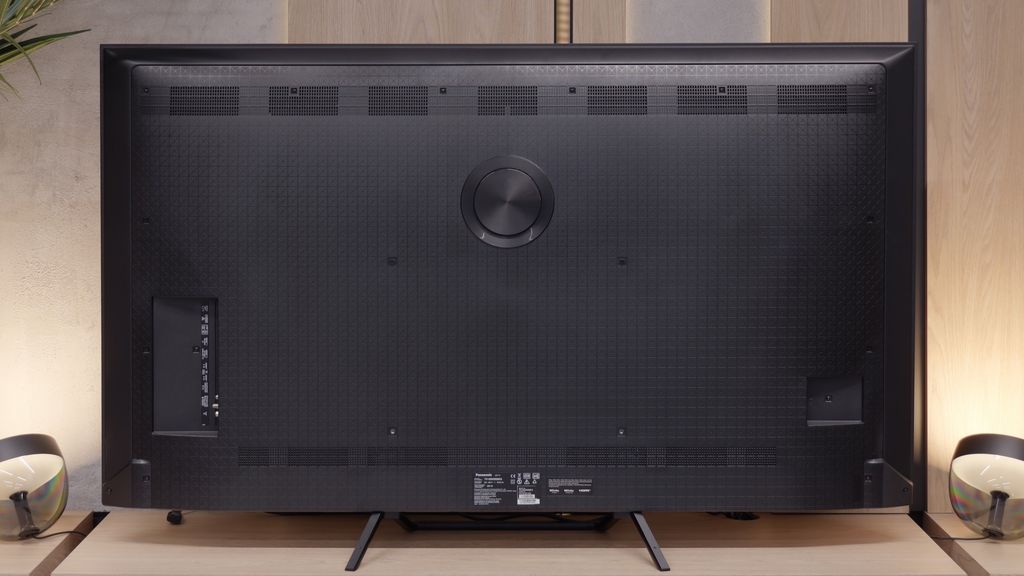
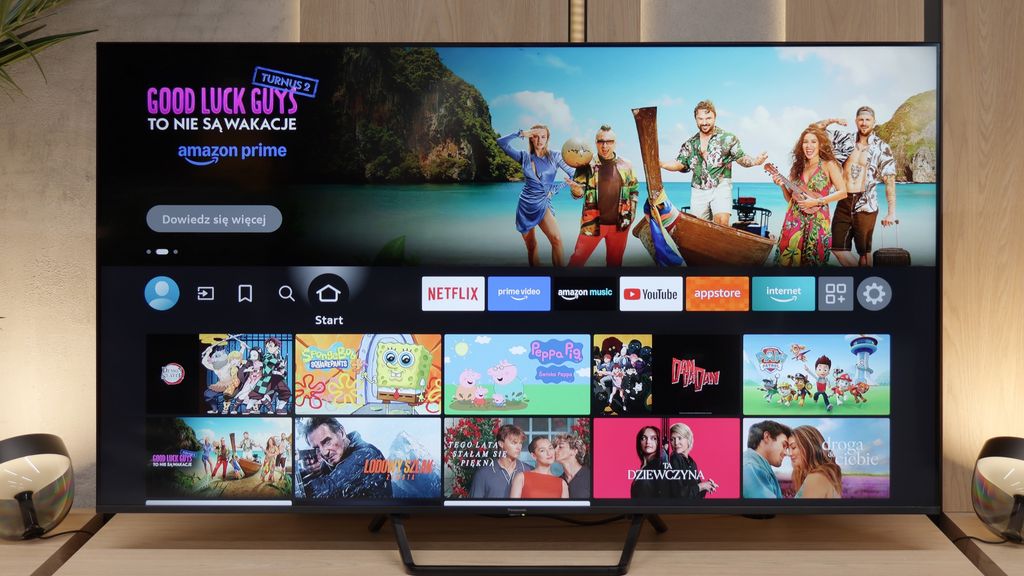



Stand: Fixed
Flat design: No
Accessories: Stand
The Panasonic W95B is a solidly constructed television that makes a good impression from the very first glance. The design is tidy, with narrow bezels and a single, stable stand. There’s little to criticise here – just good equipment. One might only notice that the whole is quite hefty, and the casing is largely made of plastic, which may not appeal to everyone.
Buy at the best price
Select size:
PANASONIC W95B - Contrast and black detail
7.5/10
Local dimming function: Yes, number of zones: 504 (18 x 28)

Result
175,300:1

Result
28,450:1

Result
19,450:1

Result
8,600:1

Result
5,400:1
Visibility of details in the lights:
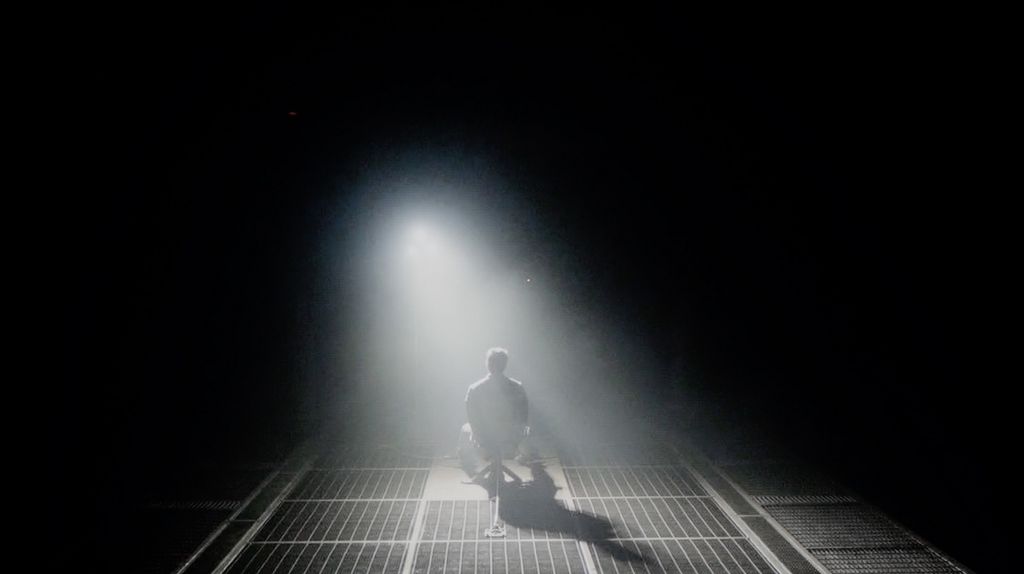
We tested the 65-inch variant, equipped with as many as 504 local dimming zones. The Panasonic W95B is an LCD television with a VA panel, but the most important feature is the use of Mini LED backlighting with precise zone control. The results we managed to achieve are truly impressive – in easier scenes, the contrast can reach six-digit values, making it at times easy to confuse this screen with an OLED. Of course, this model is not an OLED and in more demanding sequences, certain limitations resulting from the operation of the zones can be observed; however, it must be admitted that Panasonic has refined its algorithms to near perfection. Local dimming is practically invisible in action – the image remains coherent, without obvious defects or the effect of excessive "bleeding" of light. Details in dark areas are preserved, and the transitions between brightness and black look exceptionally natural.
PANASONIC W95B - HDR effect quality
5.7/10
Supported formats: HDR10, HDR10+, Dolby Vision, Dolby Vision IQ, HLG Color gamut coverage: DCI P3: 93.0%, Bt.2020: 71.0%
Luminance measurements in HDR:

Result
1145 nit

Result
229 nit

Result
636 nit

Result
198 nit

Result
740 nit
The Panasonic W95B is truly a bright screen, capable of achieving a peak luminance of around 1400 nits. In brighter, well-lit film scenes, this value translates to spectacular HDR effects that can make a big impression. However, knowing our test setup, you can probably see that in very demanding shots – such as the moon in the distance or the lights of a helicopter in the scene from Sicario 2 – the television does not impress. In such situations, brightness drops to around 200 nits, which makes the HDR effect much less noticeable. This happens because Panasonic prioritises maintaining deep blacks, not illuminating the background – for many users, this shouldn't be a cause for concern. However, it is important to remember that in these moments the image begins to resemble SDR content. The coverage of the colour palette also deserves praise, as it reaches about 93% of the DCI-P3 space thanks to the use of a PFS filter (also known from QLED technology). As a result, most films look very good in terms of saturation and colours, preserving the cinematic character of the image.
Scene from the movie “Pan” (about 2800 nits)

Scene from the movie “Billy Lynn” (about 1100 nits)

As you well know (or maybe not 😉), it is not just numbers that create the picture, but how the television can independently adapt to the HDR signal. And here we must give Panasonic huge credit – in the W95B model, we can see the engineering prowess that translates into very mature behaviour with real film material. Although the W95B does not impress with its specifications on paper, thanks to the dynamic tone mapping feature, it can render most scenes with nearly ideal balance of brightness and contrast. Films mastered even to 4000 nits, such as "Pan", or more popular streaming content, e.g. the scene from "Billy Lynn", look exemplary here. The visibility of details in bright parts of the image, especially where high levels of luminance appear, is at an excellent level. Hats off to Panasonic!
HDR luminance chart:
HDR luminance
Thanks to the dynamic tone mapping feature, even with a static HDR10 signal, the picture on the Panasonic W95B looks truly convincing. However, this is just a teaser of what the television can achieve when playing content with dynamic metadata, such as Dolby Vision. The Panasonic W95B supports both HDR10+ and Dolby Vision, which is a significant advantage – especially in a world where some manufacturers choose selective support for these formats. As seen in the comparison image below, thanks to the dynamic metadata, the television can present significantly more details, better controlling contrast and brightness in various parts of the image, even though it already performs very well with HDR10.
Static HDR10

Dynamic: Dolby Vision

Factory color reproduction
5.1/10
In Filmmaker mode, the Panasonic W95B offers an image with quite accurate colour reproduction, although it is not without minor imperfections. The white balance slightly veers towards red, which may cause a subtle warming of the image, and the gamma curve is slightly elevated, making the screen appear a bit brighter. It is good that the manufacturer included this mode – even in factory configuration, it provides a reasonably natural appearance for films. However, knowing how susceptible Panasonic televisions are to calibration, we decided to see how much the image could be improved after professional tuning.
Color reproduction after calibration
9.1/10
After professional calibration, the Panasonic W95B shows what it is truly capable of. Colour errors have mostly dropped below values of 2–3, making them practically invisible to the human eye. It was also possible to correct the excess red in the white balance, which has resulted in the image no longer having a slight pink tint, and details in dark areas are no longer lost due to excessive dimming in the gamma. In HDR content, the improvement is also noticeable – colour saturation is now more stable and does not shift so markedly towards blue as it did before. This is truly an excellent television for watching films and series in the highest possible quality. While we know that Mini LED screens are not always perfect for this, the W95B is a perfect example that with proper fine-tuning, an effect close to OLEDs can be achieved.


PANASONIC W95B - Smoothness of tonal transitions
9.5/10
In terms of the fluidity of tonal transitions, the Panasonic W95B performs exceptionally well. In the vast majority of scenes, the gradation is practically imperceptible, making the image look exceptionally smooth and natural. Minimal issues only occur in extreme shades of grey, which are extremely rare and difficult to detect with the naked eye. This is a level that will satisfy even the most demanding users.








Image scaling and smoothness of tonal transitions
7.8/10
Smooth transition function
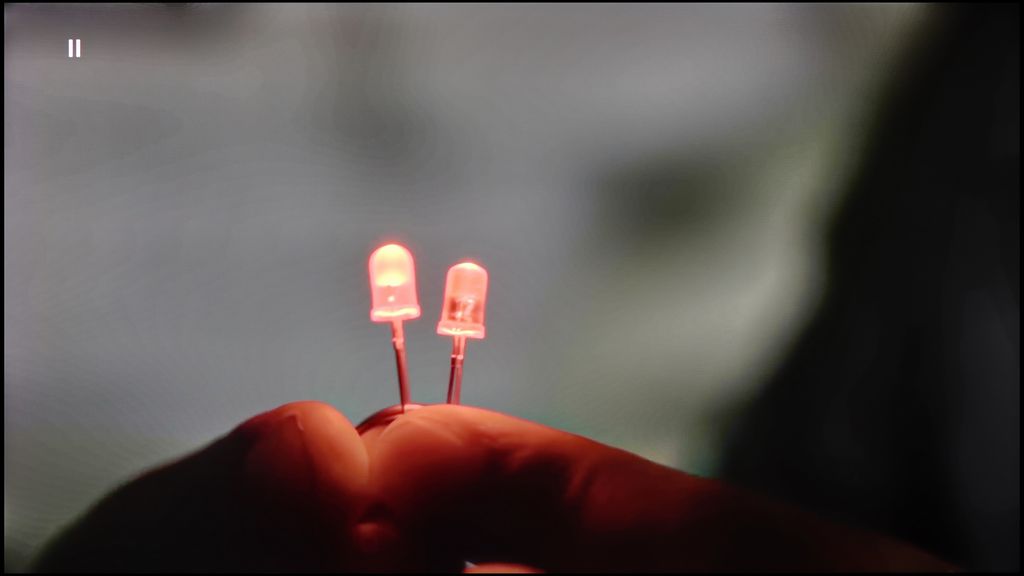
Image without overscan on the SD signal

In terms of image processing, the Panasonic W95B performs excellently. The proprietary processor responsible for digital image processing effectively upscales lower resolution content to 4K, preserving a great deal of detail and a natural appearance of contours. The final effect is impressive – the upscaling here is at a truly high level, and Full HD content can look surprisingly good. The way the television smooths tonal transitions in low-quality materials is also noteworthy. The algorithm does not operate as aggressively as in some competing models, but as a result, it does not cause a loss of detail or blur film grain.
PANASONIC W95B - Blur and motion smoothness
7.8/10
Maximum refresh rate of the panel: 144Hz
Film motion smoothing option: Yes
Blur reduction option: Yes
BFI function 60Hz: No
BFI function 120Hz: No

The 144 Hz panel used in the Panasonic W95B offers excellent fluidity, although in practice, due to the appearance of television content or the limitations of new generation consoles, it is worth observing its performance at a refresh rate of 120 Hz. In this mode, the television performs superbly – despite being a VA panel, which is not known for the fastest pixel response times, motion blur here is minimal and difficult to detect with the naked eye.
Blur (native resolution, maximum refresh rate):



Blur (BFI function enabled):



Smużenie (4K@144Hz):



A huge advantage is the proprietary Intelligent Frame Creation system, which is a motion smoother that allows you to adjust the fluidity to your own preferences – both in films and in sports.
The Motion Blur Reduction slider is responsible for fluidity in sports broadcasts – we recommend setting it to the maximum value to ensure the image is as clear and readable as possible during fast movements.
On the other hand, Film Smoothness adjusts the presentation of materials with a low frame rate, such as series and films – it can be set according to preferences: lower values give a cinematic character, while higher values create a super-smooth, theatrical effect.
PANASONIC W95B - Console compatibility and gaming features
9.8/10
ALLM: Yes
VRR: Yes
VRR range: 48 - 144Hz
Dolby Vision Game Mode: Yes
Correct implementation of HGIG: Yes
1080p@120Hz: Yes
1440p@120Hz: Yes
4K@120Hz: Yes
Game bar: Yes
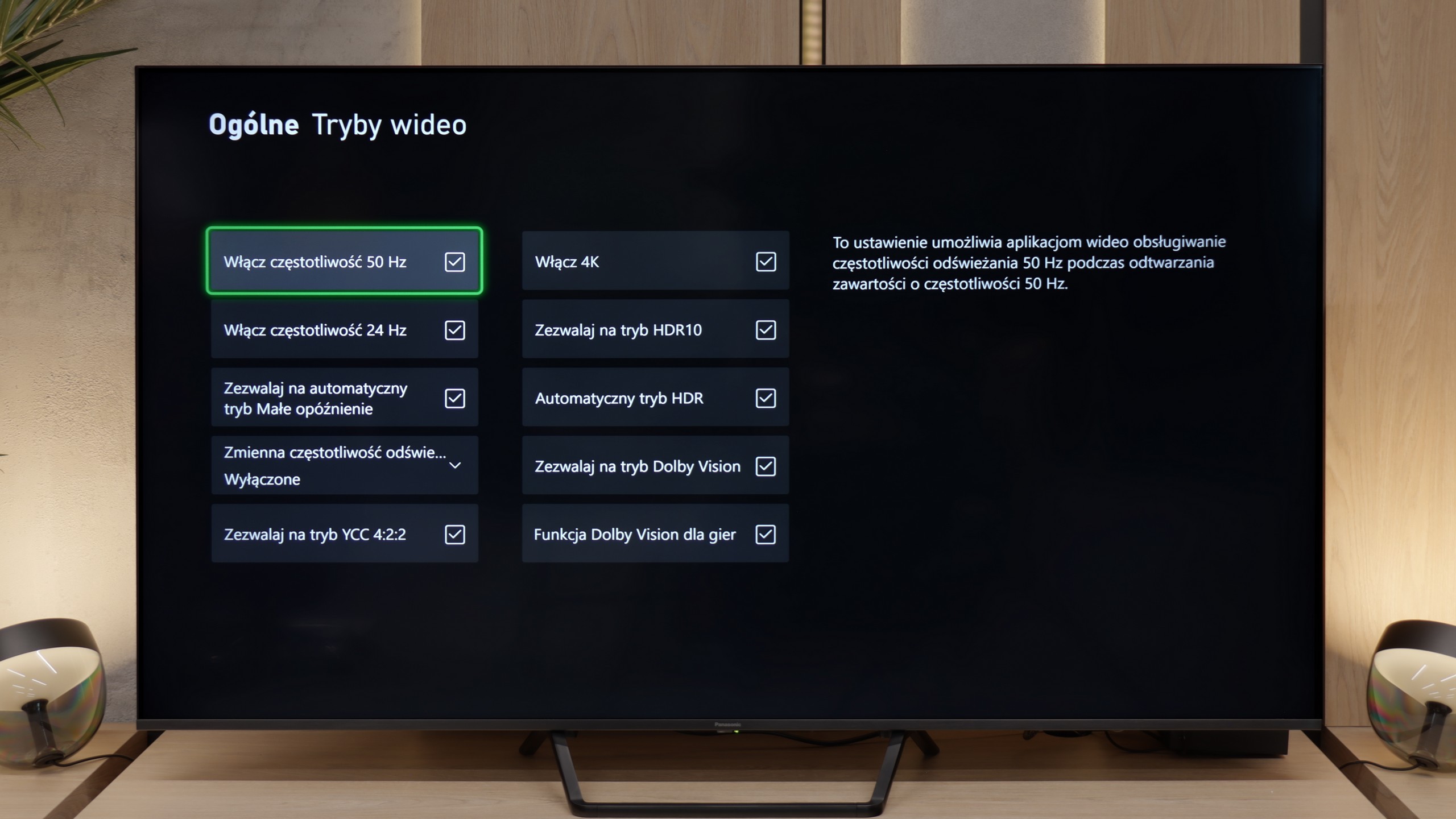
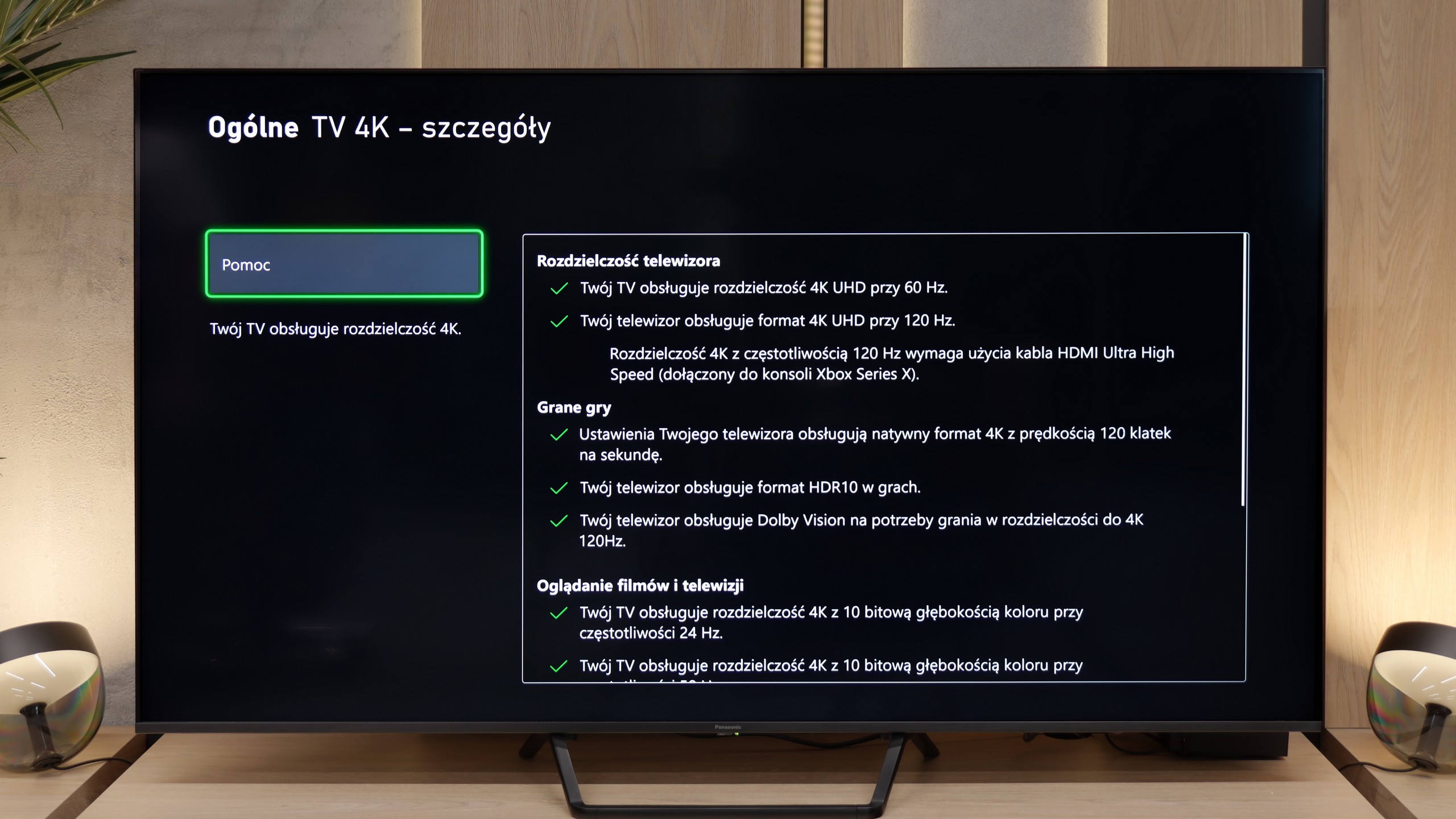
Aside from the previously mentioned drawback related to the VRR mode, in which local dimming does not work, the Panasonic W95B is a true gaming monster. The television offers practically everything that gamers can expect – perhaps except for four HDMI 2.1 ports, as there are only two available. Onboard, we find an auto low latency mode (ALLM), properly implemented HDR modes for gamers, including HGiG, as well as support for Dolby Vision in games. It is all complemented by an interestingly designed Game Bar, presented in the form of circles. While it may not be the most visually attractive, it serves its purpose – allowing quick access to key game parameters and adjusting settings without entering the system menu.
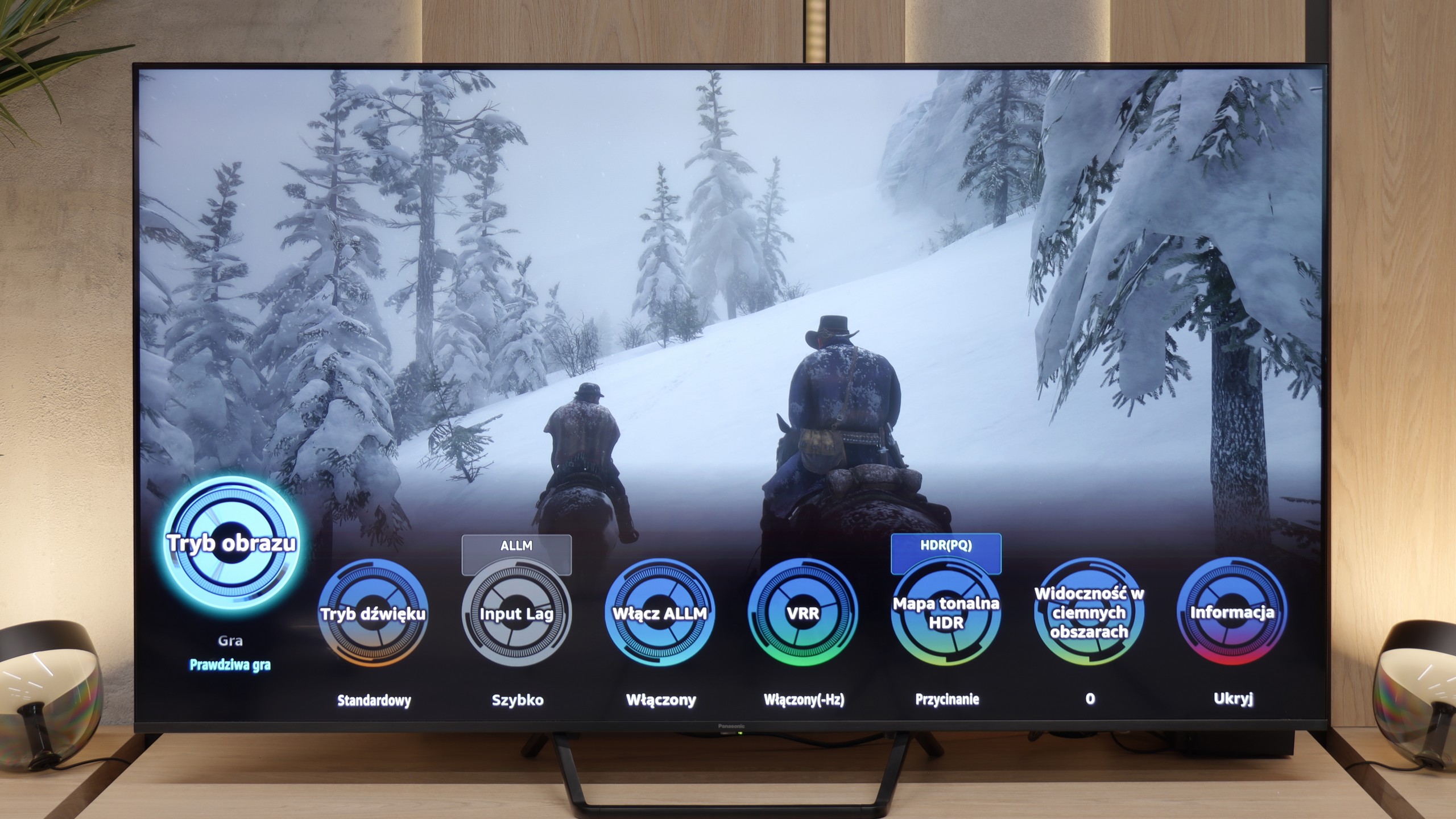
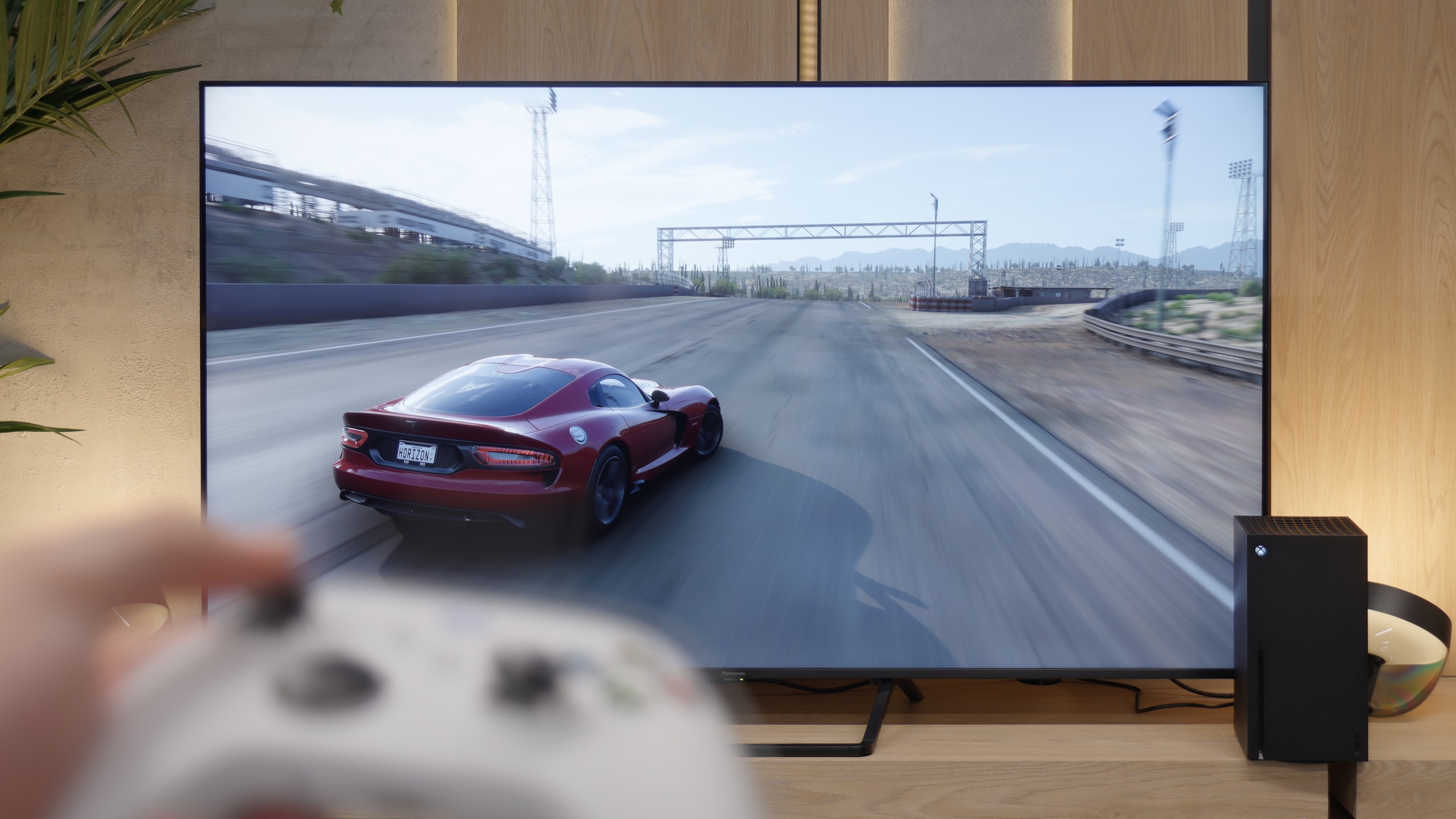

PANASONIC W95B - Input lag
9.8/10
The Panasonic W95B offers a very low input lag – around 11 ms at 120 Hz content and 20 ms at 60 Hz. Although on paper these are not record-breaking results that could impress the most demanding esports players, in practice the difference is practically imperceptible. During testing, even in dynamic, fast-paced titles, we did not notice any delay in reaction. The television responds instantly, and gameplay remains smooth and comfortable. This level is more than sufficient for both console gaming and more demanding online productions.
| SDR | HDR | Dolby Vision |
|---|---|---|
| 1080p60: 20 ms | 2160p60: 1 ms | 2160p60 DV: 18 ms |
| 1080p120: 11 ms | 2160p120: 10 ms | 2160p120 DV: 9 ms |
| 2160p60: 20 ms | ||
| 2160p120: 11 ms |

PANASONIC W95B - Compatibility with PC
8.4/10
Chroma 444 (maximum resolution and refresh rate): Yes
Font clarity: Good
Readability of dark text and shapes: Good
Input lag in PC mode (4K, maximum refresh rate): 10ms
Matrix subpixel arrangement: BGR
Max refresh rate: 144Hz
G-Sync: Yes
The Panasonic W95B performs very well when used with a computer. Thanks to its gaming panel with a 144 Hz refresh rate and support for G-Sync and AMD FreeSync, the screen provides a smooth image without the tearing effect, which will be appreciated not only by gamers but also by those using the television as a large monitor. It is also comfortable to work on daily – fonts are readable and the image is sharp. Although they are not as clear as in the case of IPS panel screens, for most users the quality of text display will be fully satisfactory.
PANASONIC W95B - Viewing angles
2.9/10
Brightness drop at an angle of 45 degrees: 80%
Unfortunately, this is the Achilles' heel of the Panasonic W95B model – as with most televisions equipped with a VA panel without additional coatings to widen the viewing angles. Colours start to fade even with a slight deviation from the screen's axis, and the contrast noticeably decreases. For this reason, when watching, it’s best to sit as directly in front of the television as possible to fully utilise the potential of the image.
PANASONIC W95B - Daytime performance
7.2/10
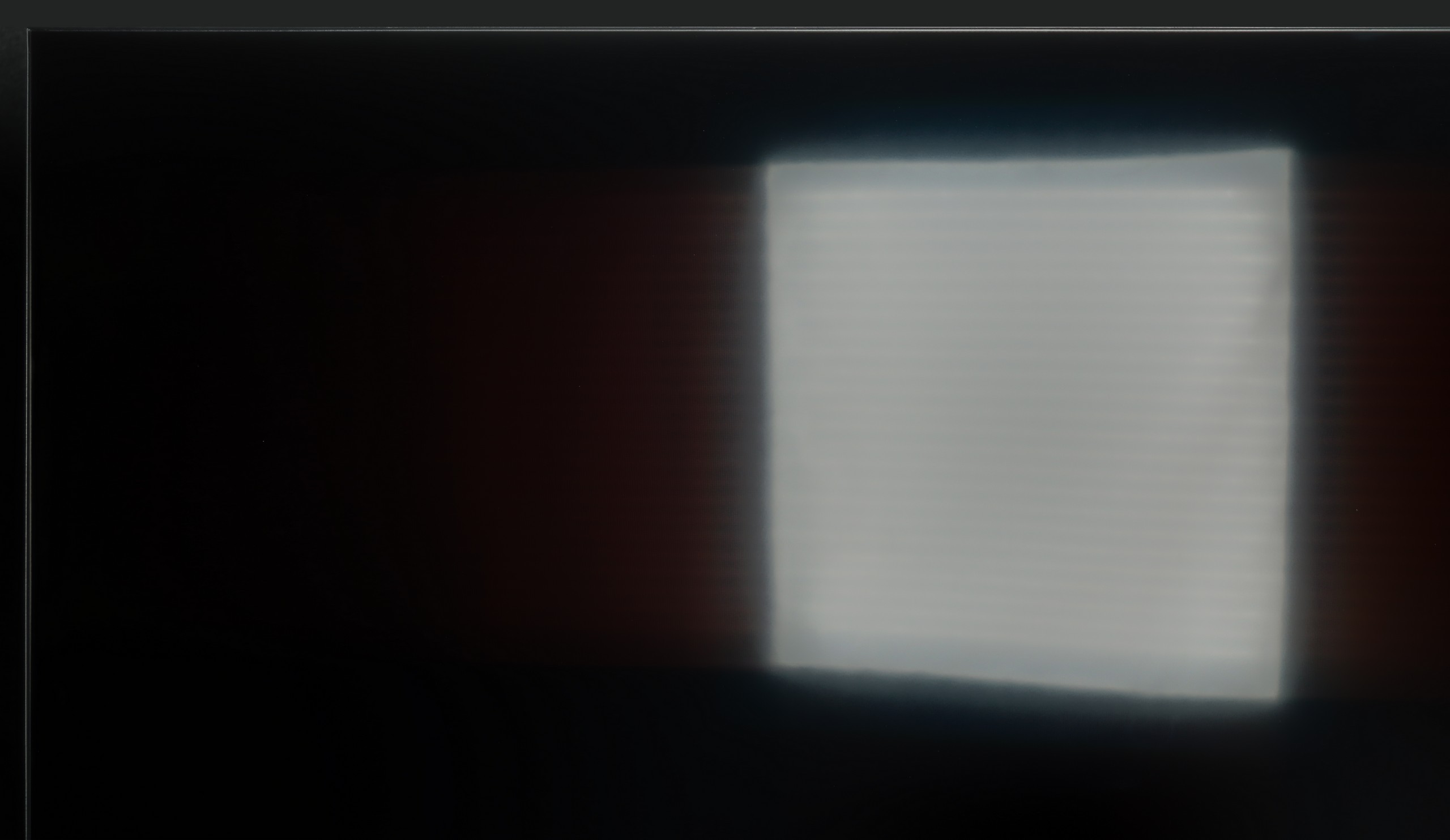

Panel finish: Satin
Reflection suppression: Good
Black levels during daytime: Good
The satin finish of the panel used in the Panasonic W95B effectively suppresses light reflections, ensuring that the screen remains readable even in brightly lit rooms. However, the greatest advantage of this model is its high brightness – when viewing everyday content, it reaches around 700 nits, which is more than sufficient even in very demanding daytime conditions. The television performs exceptionally well in living rooms with large windows or when watching on a sunny day, maintaining appropriate contrast and colour saturation without sacrificing visual comfort.
Panel brightness
Average luminance SDR
Panasonic W95B: 673 cd/m2
PANASONIC W95B - TV features
6.8/10
System: Amazon FireTV
System performance: Average
- HDMI inputs: 2 x HDMI 2.0, 2 x HDMI 2.1 48Gbps
- Outputs: Toslink (Optical audio), eARC (HDMI), ARC (HDMI), Mini-Jack (Headphones)
- Network Interfaces: Wi-Fi 2.4GHz, Wi-Fi 5GHz, Ethernet (LAN) 100Mbps
- TV reception: DVB-T, DVB-T2, DVB-S, DVB-S2, DVB-C
Classic features:
Recording to USB (terrestrial TV): Yes
Recording programming: No
Picture in Picture (PiP): No
RF remote control (no need to aim at the screen): RF
Backlit remote control: No
Teletext: Yes
Audio only mode: Yes
Bluetooth headphones support: Yes
Simultaneous Bluetooth headphones & TV audio: Yes
Smart features:
AirPlay: Yes
Screen mirroring (Windows Miracast): Yes
Voice search: Yes
Voice search in native language: No
Ability to connect a keyboard and mouse: Yes


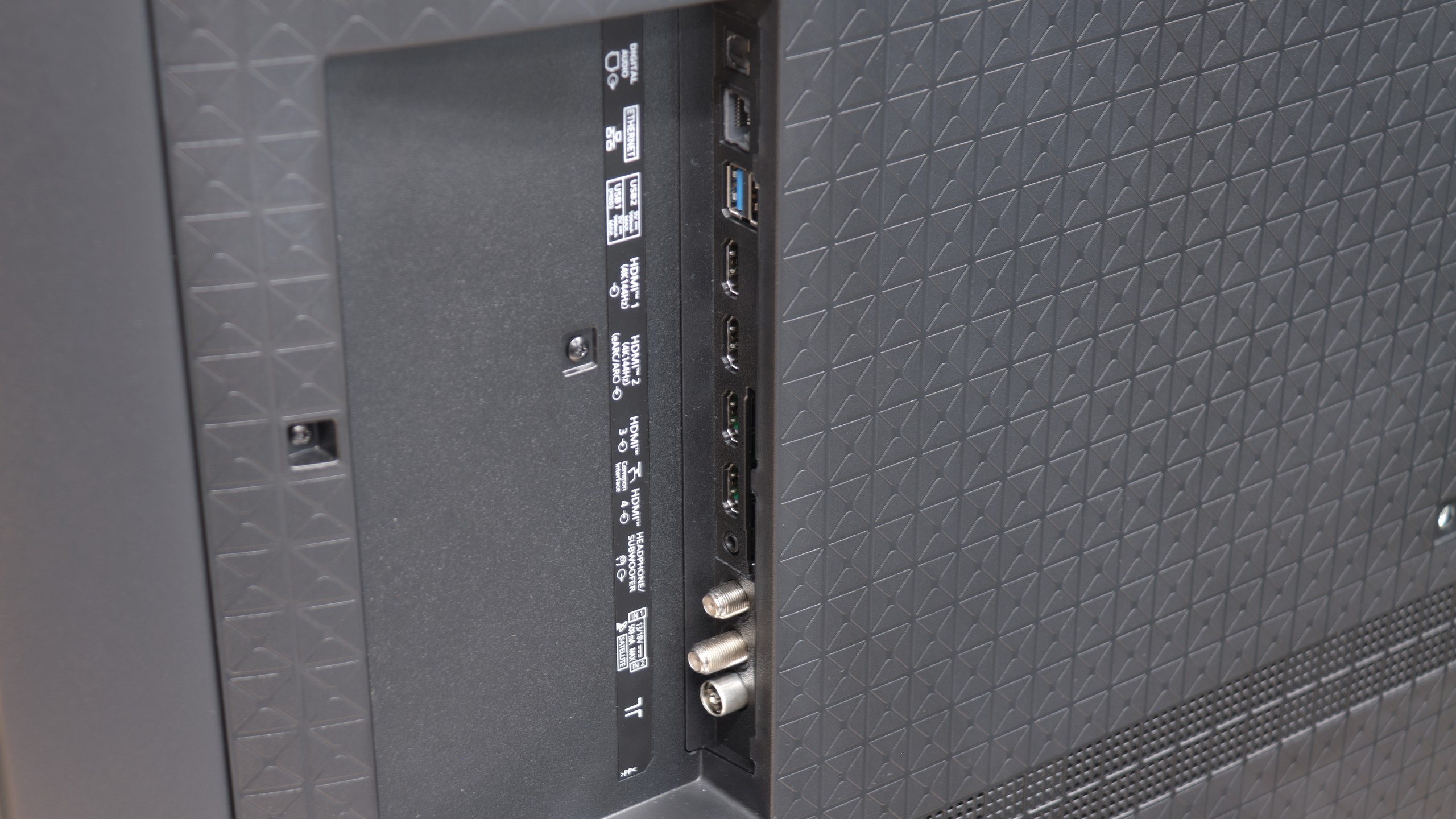



SmartTV Features W95B
Unfortunately, this is yet another Achilles' heel of the Panasonic W95B model. The operating system Fire TV used here in its European version is poorly refined - it lacks many key applications, and the interface sometimes operates clumsily and sluggishly. Although we find basic features such as AirPlay and Screen Mirroring, it is a poor consolation compared to the efficient performance of platforms from other manufacturers. As a result, despite the excellent picture quality, the television falls short of expectations in terms of software.
User Features W95B
In terms of user features, the Panasonic W95B presents itself much better. The television offers Bluetooth, a classic well-equipped remote control, and the ability to record programmes to USB from the built-in terrestrial TV tuners – a rarity that is missing in many competitive models. An additional advantage is the presence of a jack headphone socket, which will certainly please users of older home cinema systems or traditional wired headphones. In terms of hardware equipment, therefore, the W95B is a solid and complete television.
Sound connection options
HDMI audio:
Other audio outputs:
Toslink: Yes
Stereo (Mini-Jack): Yes
Wireless audio:
Bluetooth: Yes
Obsługiwane formaty audio:
Dolby Digital Plus 7.1: Yes
Dolby True HD 7.1: No
Dolby Atmos in Dolby Digital Plus (JOC): Yes
Dolby Atmos in Dolby True HD: No
DTS:X in DTS-HD MA: No
DTS-HD Master Audio: No
Ułatwienia dla seniorów
Numeric keyboard on TV: Yes
Font size adjustment: No
Audio description: Yes
PANASONIC W95B - Apps
7.2/10























PANASONIC W95B - Playing files from USB
3.1/10
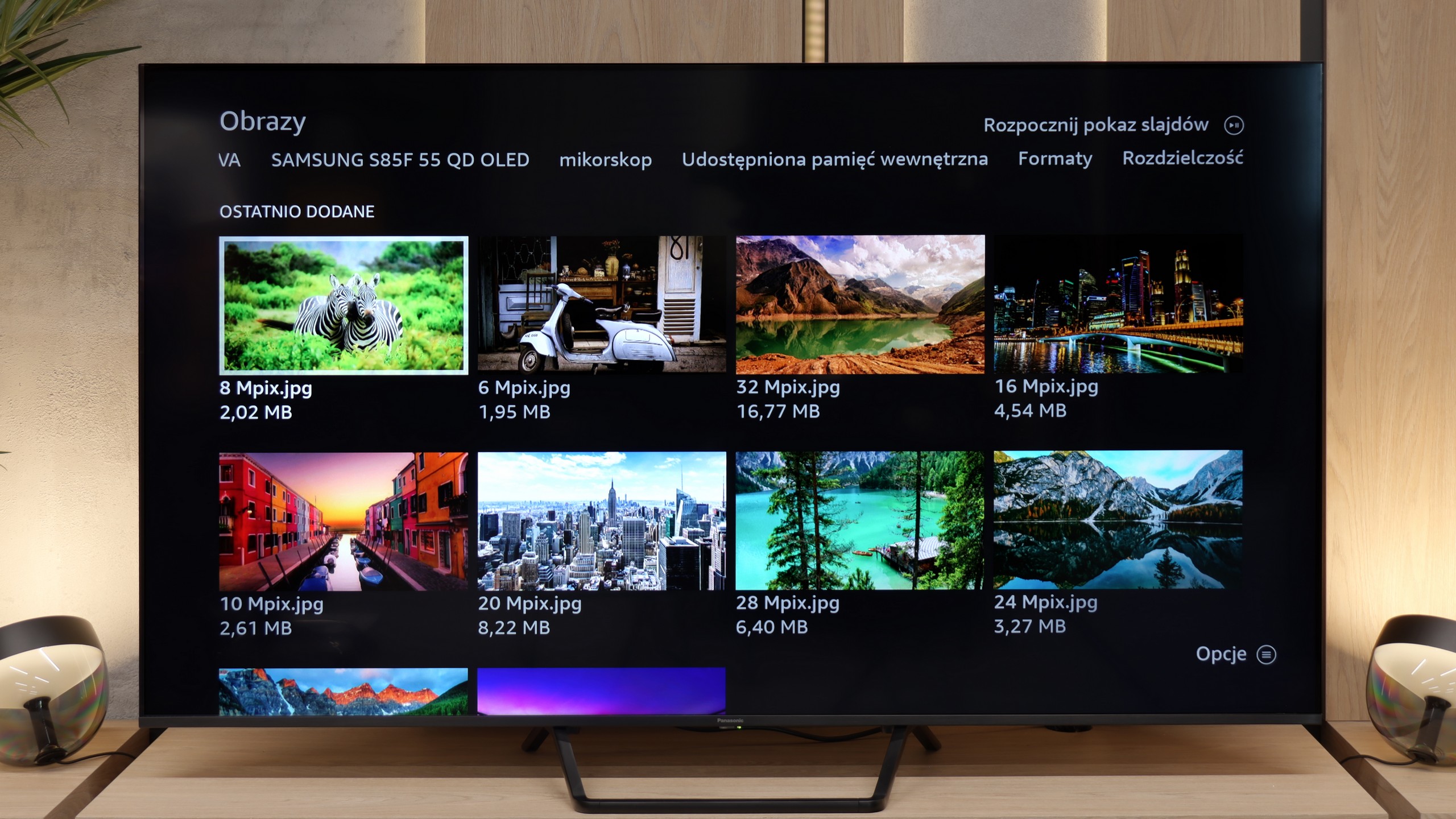
| Maximum photo resolution: | Supported photo formats: |
|---|---|
This is another shortcoming of the Fire TV system used in the Panasonic W95B. If someone has their own movie library and plans to play it directly from a USB drive or external hard drive, they may be disappointed. The television manages reasonably well only with displaying photos, such as from holidays, whereas video playback is heavily limited. The biggest issue is the lack of subtitle display when playing films from USB. Therefore, if you care about watching files from your own collection, it is definitely better to use an external media player.
PANASONIC W95B - Sound
7.9/10
82dB
Maximum volume
Supported codecs
(TV speakers)
Dolby Digital Plus 7.1
Dolby True HD 7.1
Dolby Atmos in Dolby Digital Plus (JOC)
Dolby Atmos in Dolby True HD
DTS:X in DTS-HD MA
DTS-HD Master Audio

The Panasonic W95B performs surprisingly well for a television. The sound is clear and spatial, and thanks to the subwoofer located at the back, you can even hear a slightly noticeable bass, which is not common in televisions of this class. The overall sound quality is at a very high level here, allowing you to comfortably watch films and series without the need to connect an external audio system. Of course, it is known that if someone wants to watch in really high quality, it is worth connecting a soundbar – especially since the Panasonic W95B supports Dolby Atmos format, thus seamlessly transmitting spatial sound to it. The only thing missing is support for the currently less popular DTS:X format, which is simply not available in this model.
Acoustic Measurements
82dBC (Max)
75dBC
PANASONIC W95B - Panel details
Software version during testing: RS8141/3009
Subpixel Structure:
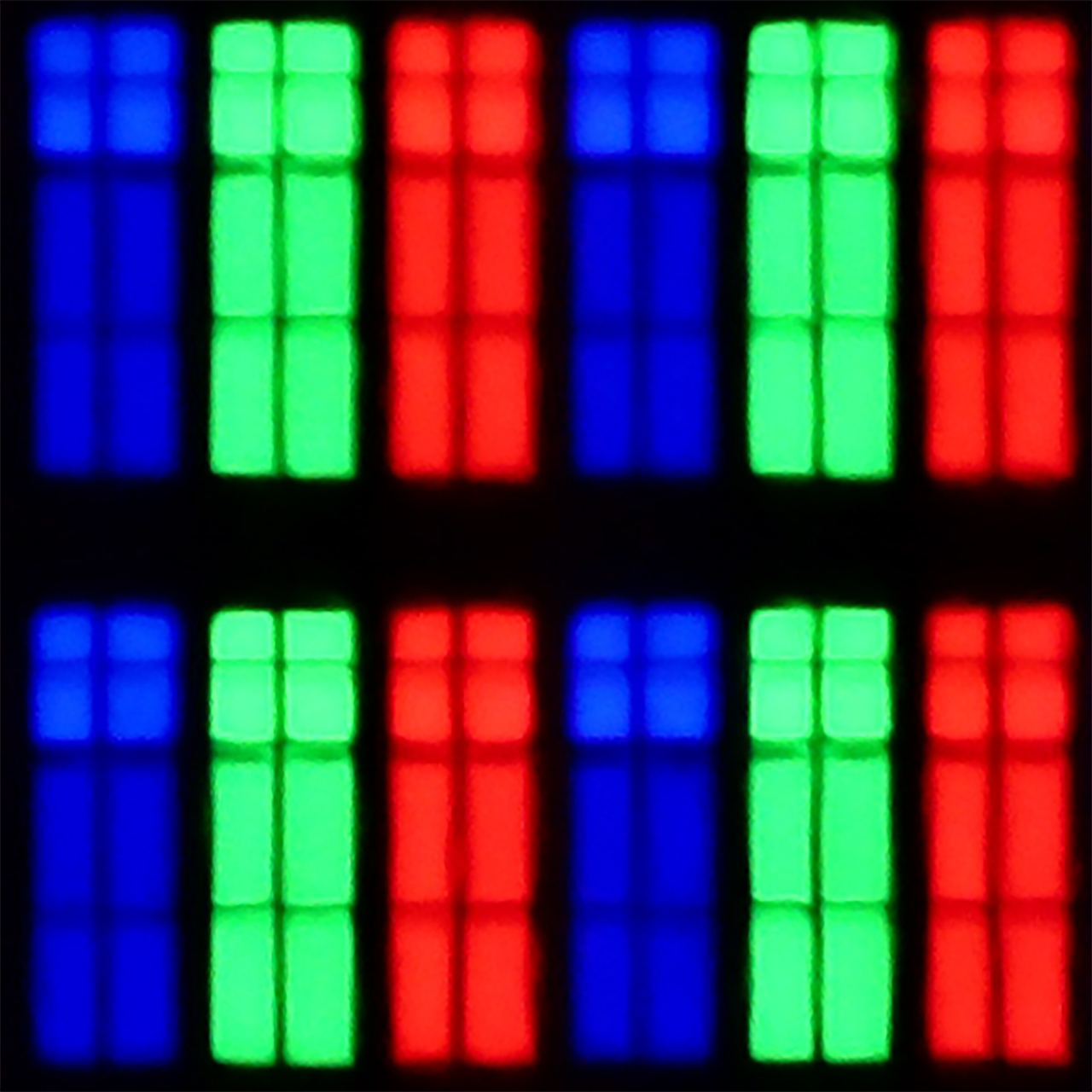
Panel uniformity and thermal imaging:
Backlight Type: PFS LED

Founder and originator of the "ChooseTV" portal

Journalist, reviewer, and columnist for the "ChooseTV" portal






